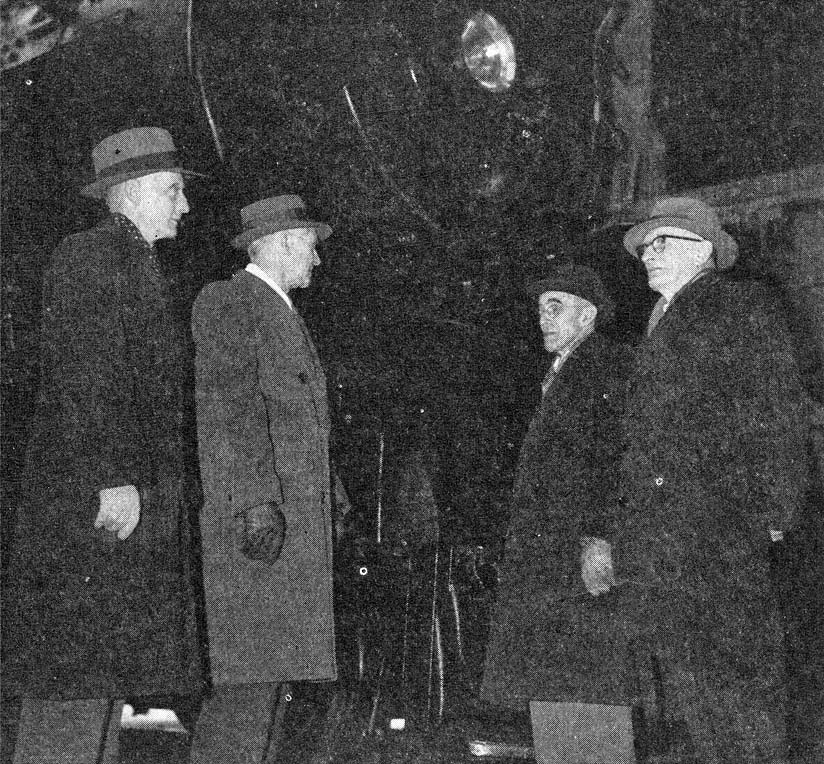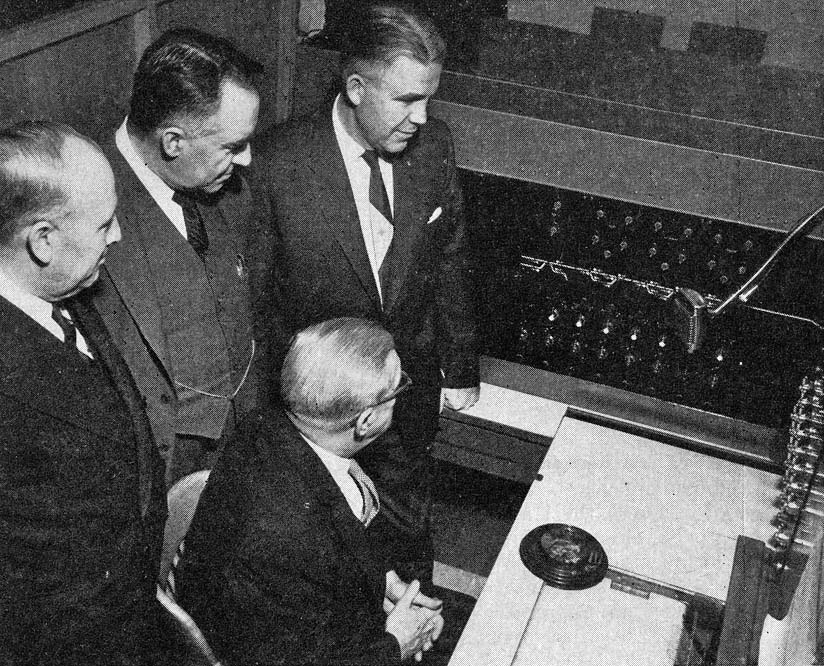
Joined in Retirement by Brothers

Another phase of the steam locomotive era came to an end in Montreal when Canadian Pacific locomotive 2409 puffed out of the gigantic locomotive
repair shop at Angus Shops, leaving the shed bare and empty, probably for the first time in 54 years. The general overhaul that had just been completed
on Engine 2409 was the last that ever will be undertaken at Angus Shops, because of the dieselization program.
Ever since 1904 Canadian Pacific locomotives by the thousands had gone into the shops from all parts of the system for general overhauls that saw them taken apart from rail to smokestack and put together again.
Throughout the years, the lives of two sets of brothers, the Harveys and the Musgroves, closely followed that of the locomotive shop. When it opened in 1904, G.W. Musgrove already had been an apprentice for a year, while F.J. Musgrove, E.J. Harvey, and Frank Harvey all were to join as apprentices the following year.
And within the past few months, all four men have retired from active service, Frank Harvey on the day that the job was completed on Engine 2409. With the exception of E.J. Harvey, who became production manager for all of Angus Shops, the group all remained in the locomotive shop throughout their careers, with F.J. Musgrove becoming general foreman.
Between them, their service with the Company added up to 204 years and five months, a service record seldom equalled by any group of four men in the
same shops, let alone by two sets of brothers. For them, at least, it was a sentimental moment when Engine 2409 rolled out of the shop. Their memories
rolled back through the years to the day when they signed on at 7 cents an hour and waited six weeks for the first pay check. And each agreed that he
would do the same thing all over again, given the chance.
New Centralized Traffic Control System is Inaugurated

ON 28 Jan 1958 the first major step in long distance operation of trains by Centralized Traffic Control became a reality when D.S. Thomson
vice-president, turned the switch and signal levers to route Train 35 through Glen Tay on the Company's Belleville Subdivision. Other Company officials
attending this ceremony included G.H. Baillie vice-president Eastern Region, J.R. Strother general manager, and G.W. Miller regional engineer.
This new Centralized Traffic Control system permits control of signals and switches by a dispatcher seated before the control panel in Toronto. The position of all switches, signals, and locations of trains on his territory are indicated by lights on a track diagram. Since all trains operate entirely by signal indication, C.T.C. does away with train orders. Sidings, having a capacity of 150 freight cars, spaced 9 to 11 miles apart will permit meets to be made with the least possible delay as trains will no longer have to stop to hand throw switches.
By the end of 1958, the Company's forces will have installed C.T.C. on the Belleville Subdivision (Glen Tay to Trenton), a distance of 87.1 miles. The C.T.C. control panel is designed to permit this electronic train control system to be extended to Agincourt over the Oshawa Subdivision.
At present, the Company has a total of 52.1 miles of C.T.C. in operation across the system at 10 various locations, mainly in terminal areas.
Nerve centre for the Company's new C.T.C. operation on the Eastern Region is located in the Toronto Union Station. By means of miniature levers and push buttons, the dispatcher can operate switches and clear signals to permit various train movements.
The progress of trains is shown on the track diagram by various colored lights. A graph automatically makes a permanent record of the trains position at all times.
Prior to the installation of Centralized Traffic Control on the Belleville Subdivision (Glen Tay to Trenton) there was a total of 16 sidings, 60 to 80 car lengths long, that required use of hand throw switches whenever a train had to move off the main track.
Under the new system, eight sidings will be removed and the remaining eight lengthened to a 150 car capacity. These sidings have switches at each end that are electric power operated and remotely controlled by the dispatcher in Toronto.
The major items of signal equipment were manufactured by the General Railway Signal Company of Rochester, New York. The control and indication system is known as "Syneroscan" and is one of the latest developments in railway signalling. A large portion of the system is electronical and it utilizes hundreds of miniature radio tubes.
The design and installation of the system was under the direction of R.I. Becksted signal engineer, and Douglas Walkington assistant engineer, in charge of C.T.C. installation. Others assisting in the signal installation included: E. Pitt assistant signal engineer, J.R. Taylor signal field supervisor, E.G. Prinn signal construction supervisor, and G.C. Gunning assistant signal construction supervisor.
 and is reprinted here with their permission.
All photographs, logos, and trademarks are the property of the Canadian Pacific Railway Company.
and is reprinted here with their permission.
All photographs, logos, and trademarks are the property of the Canadian Pacific Railway Company.